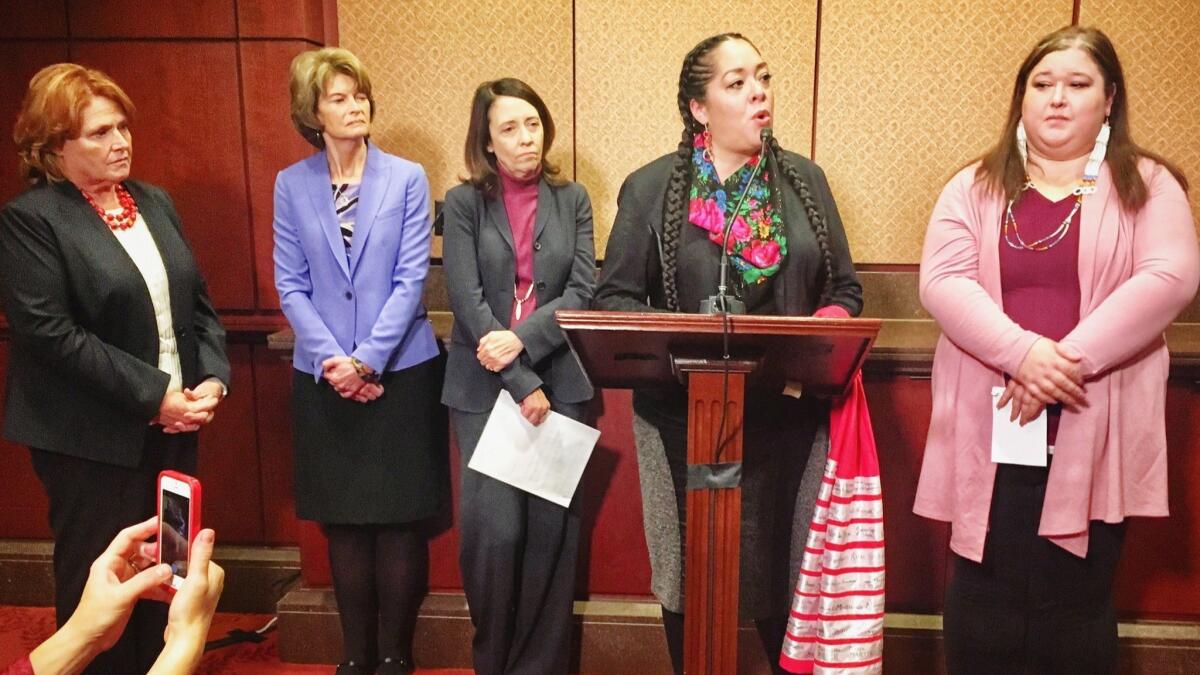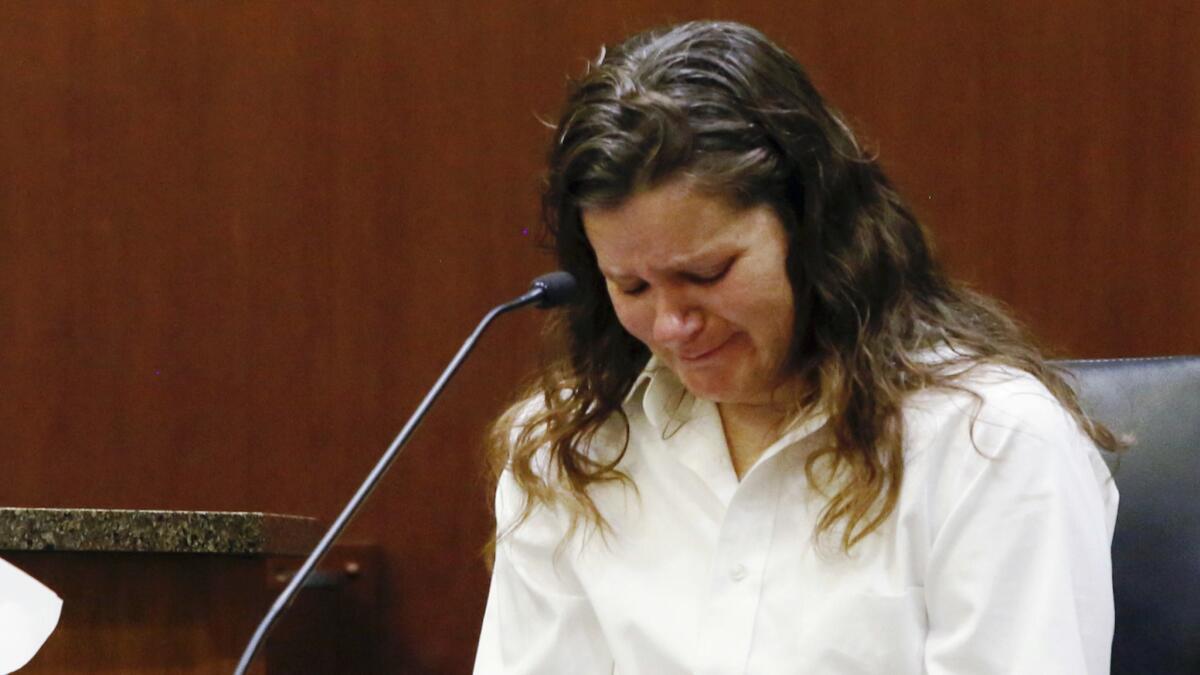Global Development: The horrific death of a Native American woman spurs action in Congress

- Share via
Reporting from Washington — A year ago in August, during her last month of pregnancy, Savanna LaFontaine-Greywind placed a pizza delivery order to her family’s Fargo, N.D., apartment before heading upstairs to see a neighbor.
It was the last time LaFontaine-Greywind’s parents would see her alive.
For the record:
10:40 a.m. Nov. 18, 2018In an earlier version of this article, the caption on the lead photo identified the co-author of a UIHI report as Anna Lucchesi. Her name is Annita Lucchesi.
Kayakers found the 22-year-old woman eight days later, wrapped in plastic, her body jammed against a log by the wicked current of the nearby Red River. Her baby had been gruesomely cut from her womb. Police found the healthy newborn 72 hours earlier on the bed of her neighbor, Brooke Crews.
Crews was arrested, pleaded guilty and was sentenced to life without parole. Her live-in boyfriend, William Hoehn, was also sentenced to life for conspiring to kidnap Savanna’s baby, Haisley Jo.

The story might have ended there. But a perception that police reacted too slowly after LaFontaine-Greywind’s disappearance sparked outrage that reached all the way to Congress.
On Wednesday, the Senate Committee on Indian Affairs unanimously approved Savanna’s Act, introduced by Sen. Heidi Heitkamp (D-N.D.), who named the bill after the slain member of the Spirit Lake tribe.
The legislation would improve and expand access to data on Native American crime victims, establish police protocols and require annual reports to Congress on the number of missing and slain Native American women.
The vote followed release of a report by the Urban Indian Health Institute that argued that too little attention is paid to Native American women who are victims of violent crime in U.S. cities, rather than on reservations. The report identified 506 cases of indigenous women who have gone missing or were killed in 71 U.S. cities since 1943. Of those, 280 were classified as homicides, 128 as missing persons cases, and the remainder were unknown.
The Urban Indian Health Institute, which is funded by the federal government’s Indian Health Service, said the cases it found had largely slipped through the cracks and were not included in most statistical surveys of violence against Native Americans, which are focused on tribal areas.
Heitcamp, who recently lost her bid for reelection to the Senate, argued that her bill is needed to improve society’s understanding of violence against Native American women.
“This is a devastation that has gone on too long,” she said. “You will never solve a problem that you don’t have data on; that you don’t have the ability to actually analyze.”
The Urban Indian Health Institute, however, argued that the bill is an incomplete solution because it does not include urban women. Nearly three-quarters of Native Americans live in urban areas.
“Because cases occurring in urban areas are not federal jurisdiction, this means missing and murdered urban Native women and girls, including Savanna herself, would not be included in the data the bill aims to collect,” the institute wrote.
When news of LaFontaine-Greywind’s death surfaced in the fall of 2017, it sparked a media frenzy. She quickly became a symbol for the “missing and murdered” advocacy movement, which argues that the problem of missing and slain Native American women is greater than people realize.
It’s unclear just how extensive the problem is. A review of the FBI’s 2017 violent crime report lists incidents that occur on tribal lands, but does not tell anything about the gender or ethnicity of the victims.
Statistics from the Centers for Disease Control and Prevention suggest that young Native American women are less likely than other women to be victims of homicide.
The Urban Indian Health Institute argues that such statistics may reflect poor data collection, not less violence.
“This report wasn’t done because Native people needed to know how many women have been killed or have disappeared. It was done because Native people need this report to responsibly advocate for all of their women,” said Abigail Echo-Hawk, director of the institute and a member of the Pawnee Nation.
The Fargo Police Department waited four days after Savanna LaFontaine-Greywind disappeared before obtaining a warrant to search the neighbor’s apartment. Police Chief David Todd indicated that the investigation would have gone differently had officers realized the victim was dead.
This outraged LaFontaine-Greywind’s parents, who said they reported their pregnant daughter missing within four hours after she went upstairs, leaving behind her wallet and car keys.
“Police do not have the same concern about missing, deceased or injured Native American women than they would have about victims who are Caucasian,” attorney Gloria Allred said at a news conference last month. Allred, the well-known women’s rights attorney, is acting as an advocate for LaFontaine-Greywind’ parents.
A few blocks away from the unveiling of the Urban Indian Health Institute’s report, Rep.-elect Deb Haaland of New Mexico was taking selfies at Congress’ freshman orientation.
One of two Native American women ever elected to the House of Representatives, Haaland, who is a tribal citizen of the Pueblo of Laguna, is among those calling attention to violence against Indigenous women.
New Mexico had the highest number of women listed in the institute’s missing-and-dead report. The city of Gallup had more unreported cases, 20, than any other jurisdiction profiled in the research.
“It’s the biggest problem no one’s even heard about,” Haaland said in an interview.
Last fall, she said she attended a candlelight vigil in Albuquerque for Savanna Lafontaine-Greywind.
“This is not a Native congressman’s issue. Every congressman should know,” she said. “And it will require compassion for understanding where we come from and why this is happening to us.”
Monet is a special correspondent. This article was supported by a grant from the O’Brien Fellowship in Public Service Journalism.
More to Read
Sign up for Essential California
The most important California stories and recommendations in your inbox every morning.
You may occasionally receive promotional content from the Los Angeles Times.










